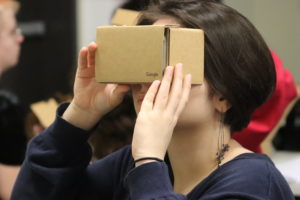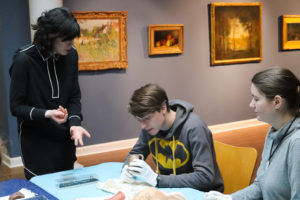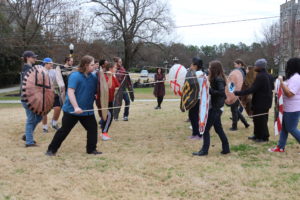Earlier this semester, Dr. Jessica Tomkins’ history classes stepped back in time in order to learn from it. Many challenges our world faces now have historical precedents and, according to Dr. Tomkins, it is a disservice to modern thinkers to ignore the lessons of the past. She asks her students to examine history through societies that have influenced us.
A fitting lens for understanding modern civilization, she argues, is Ancient Egypt, a relatively short yet culturally rich African state. To do that, Dr. Tomkins has introduced hands-on approaches for students to interpret the past and understand the present.

A history student uses a Google Cardboard headset to experience the virtual reality of Ancient Egypt.
With a quick free app download to their cellphones, students were able to access three-dimensional models of ancient structures and manipulate their environments.
Students fixed their cameras at glyphs on printer paper, and models of the Sphinx and an ancient tablet known as the dream stela came to life on their phone screens, accompanied by facts about the ancient inscriptions. Meticulously-rendered details allowed students to pore over these monuments.
By inserting their phones into a Google Cardboard headset, students took a walking tour of historic sites like the Luxor Temple, the pyramids of Giza and even the tomb of Ramesses the 6th. Immersive, 360-degree environments encouraged students to look in all directions, stand up from their seats and lean in to get a closer look at the ancient stonework and hieroglyphs.
“I do not teach ancient history as a parade of events, listing what happened and when, because students have to understand how to ask the right questions, think critically, analyze a wide variety of sources, and write persuasively and effectively in order to understand the ancient past.” – Dr. Jessica Tomkins
Augmented and virtual reality remains a relatively new, yet promising technology when it comes to educational opportunities. As seen in Dr. Tomkins’ classroom, AR and VR can, at low cost, dramatically alter the limitations of the traditional classroom setting.
While much of history is preserved in text, the collective understanding of societies like Ancient Egypt is based on inference. Using bits and pieces that have survived the millennia since the height of Egyptian civilization, historians have pieced together an expansive yet incomplete narrative. In Dr. Tomkins’ classes, she asks her students to utilize their ability to analyze and think critically in much the same way.
The ability to interact with the past provides just such an opportunity to prompt that sort of critical thinking. By creating more hands-on experiences, Dr. Tomkins hopes to make history more accessible.
Students also got the opportunity to handle real artifacts from Ancient Egypt—a rare way to experience the past without the glass walls of a museum. Dr. Tomkins arranged for the collection to be on short-term loan from the Bade Museum of Biblical Archaeology in California and under safekeeping in the Oglethorpe University Museum of Art on campus.

Students examine a collection of antiquities on loan from the Bade Museum of Biblical Archaeology in California, as Dr. Tomkins looks on.
Donning white cloth gloves and under careful supervision, students examined antiquities and guessed at their purpose. Objects that, at first, may have appeared arcane and puzzling, revealed themselves to be practical and utilitarian. Physically handling these objects, rather than viewing them on a screen, unlocked new perspectives for understanding.
“By allowing students to handle 2500-3000-year-old daily life objects, the barrier between the past and the present is broken down and we are able to appreciate that the very distant past we are studying is, at the root of it all, about people just like us who had exactly the same day-to-day needs.”

To cap off her class on ancient warfare, Dr. Tomkins had students craft shields for an exercise she calls “experimental archaeology.” By physically reenacting scholarly theories on how warfare was conducted, students could make their own deductions based on experience. After constructing large shields, students stood on Oglethorpe’s academic quad, rank and file, and tested how battles were conducted.
These hands-on opportunities supplement the traditional classroom environment, and are prime examples of how Oglethorpe instructors create personalized learning environments for students. On top of that, the perspective formed by studying ancient history opens the doors for students to ask questions about our society and establish themselves as critical thinkers in an age of rapid transition.
Throughout the semester, Dr. Tomkins also welcomes guest speakers via Skype, including experts from Yale, Harvard, Brown, NYU, and UC Berkeley on varied topics such as climate change and the ancient world, Egyptian monuments, the use of digital humanities for ancient history, Jews in ancient Egypt, and an ancient archive of papyri from the site of Tebtunis.
This fall, Dr. Tomkins will be teaching Women and Gender of the Ancient World as part of OU’s Semester of Suffrage.
